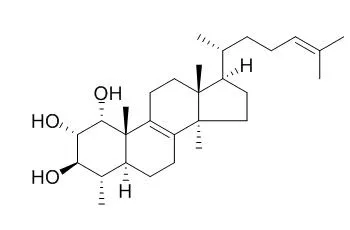| In vitro: |
| Chinese Traditional and Herbal Drugs, 2017, 48(5):853-858. | | Chemical constituents from Myrrha and their antitumor activities.[Reference: WebLink] | To study the chemical constituents of Myrrha and their antitumor activities.
METHODS AND RESULTS:
The constituents were isolated and purified by recrystallization, and open silica gel, Sephadex LH-20, ODS column chromatography, as well as preparative HPLC. The structures were elucidated based on the chemical and spectroscopic methods. Furthermore, the cytotoxicities of these chemical components against PC-3 cell lines were measured by MTT method. Eleven compounds were obtained from the chloroform extract of myrrh, and were established as (4α,11α)-2-oxo-8,11-dihydroxycadina-1(6),7,9-trien-12-oic acid γ-lactone (1), (4α,11β)-2-oxo-8,11-dihydroxycadina-1(6),7,9-trien-12-oic acid γ-lactone (2), dihydropyrocurzerenone (3), orientalol E (4), guaianediol (5), cryptomeridiol (6), cycloartane-1α,2α,3β,25-tetrol (7), cycloartan-24-ene-1α,2α,3β-triol (8), cycloartan-24-ene-1α,3β-diol (9),
29-Norlanosta-8,24-diene-1alpha,2alpha,3beta-triol (10), and octadecane-1,2S,3S,4R-tetrol-1-O-α-L-rhamnopyranoside (11).
CONCLUSIONS:
Compounds 1 and 2 are two new compounds named as (+)-myrrhalactone A and (-)-myrrhalactone A, respectively. Compounds 4 and 6 are isolated from the genus Commiphora Engl. for the first time. Compounds 8, 10, and 11 show moderate cyctotoxic activity against PC-3 cell lines. |
|






 Cell. 2018 Jan 11;172(1-2):249-261.e12. doi: 10.1016/j.cell.2017.12.019.IF=36.216(2019)
Cell. 2018 Jan 11;172(1-2):249-261.e12. doi: 10.1016/j.cell.2017.12.019.IF=36.216(2019) Cell Metab. 2020 Mar 3;31(3):534-548.e5. doi: 10.1016/j.cmet.2020.01.002.IF=22.415(2019)
Cell Metab. 2020 Mar 3;31(3):534-548.e5. doi: 10.1016/j.cmet.2020.01.002.IF=22.415(2019) Mol Cell. 2017 Nov 16;68(4):673-685.e6. doi: 10.1016/j.molcel.2017.10.022.IF=14.548(2019)
Mol Cell. 2017 Nov 16;68(4):673-685.e6. doi: 10.1016/j.molcel.2017.10.022.IF=14.548(2019)